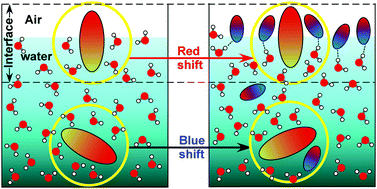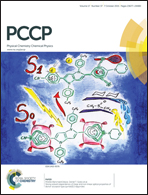Anomalous effective polarity of an air/liquid-mixture interface: a heterodyne-detected electronic and vibrational sum frequency generation study†
Abstract
We study the effective polarity of an air/liquid-mixture interface by using interface-selective heterodyne-detected electronic sum frequency generation (HD-ESFG) and vibrational sum frequency generation (HD-VSFG) spectroscopies. With water and N,N-dimethylformamide (DMF) chosen as two components of the liquid mixture, the bulk polarity of the mixture is controlled nearly arbitrarily by the mixing ratio. The effective polarity of the air/mixture interface is evaluated by HD-ESFG with a surface-active solvatochromic molecule used as a polarity indicator. Surprisingly, the interfacial effective polarity of the air/mixture interface increases significantly, when the bulk polarity of the mixture decreases (i.e. when the fraction of DMF increases). Judging from the hydrogen-bond structure at the air/mixture interface clarified by HD-VSFG, this anomalous change of the interfacial effective polarity is attributed to the interface-specific solvation structure around the indicator molecule at the air/mixture interface.


 Please wait while we load your content...
Please wait while we load your content...